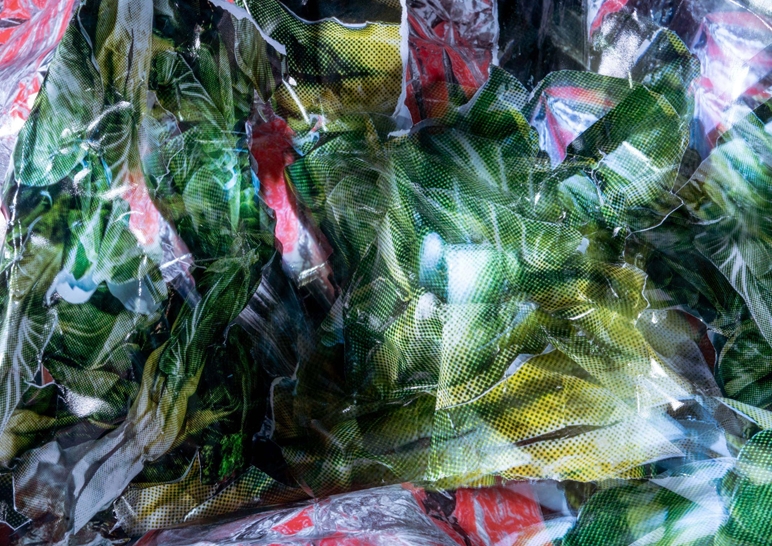
Billy Chen, a photographer and visual artist based in New York City with roots in Shanghai, probes the unstable threshold between reality and simulation through image-making that employs scanners, cameras, and found materials. His practice unfolds within the tension between the mechanical and the hand-made, the digital and the tactile. Across his body of work, Chen has pursued a sustained investigation into how digital media and the abundance of circulating images alter personal memory and challenge notions of the authentic self: “A link throughout these works,” he notes, “is my constant exploration of deconstructing photography as a medium, and utilizing photographic elements to reconstruct images.” His method is not to reject photography but to dismantle its claim to represent the real: dissecting its surface, fragmenting its logic, and reassembling it into something that acknowledges both artifice and intimacy.
The physical manipulations at the heart of Chen’s process (embedding textures into images, scanning printed photographs to emphasize paper grain and ink behavior, or cutting and subtracting backgrounds) become gestures of resistance against photography’s traditional claim to transparency. By reintroducing friction into an otherwise seamless medium, Chen draws attention to the photograph’s material presence: the dust on a scanner bed, the fiber of the paper, the glint of ink. Each mark, smudge, and residue reminds us that this piece emerged out of its own unique history, and does not exist ex nihilo. The photograph, in Chen’s work, is never a window onto the world but rather a stage on which layers of seeing and remembering perform themselves.
Viewed through what Chen calls a framework of “subject exposure,” these works also reflect his position within a digital landscape that is at once connective and distorting. “As I dive into various materials to make the works, I’m also exposed and influenced by the digital landscape,” he explains. “What does it mean to be visually Chinese through the filter of the internet? How much personal curation is actually at play?” Such questions speak to the fraught space of diasporic self-representation in an era of algorithmic visibility. The digital realm offers both archive and echo chamber, shaping the images through which one’s identity is reflected and refracted. Chen’s inquiry is thus deeply personal, yet also generational: what happens to memory when every moment is archived, copied, and circulated? What does authenticity mean when the self is constantly mediated by platforms, pixels, and performance?
These questions animate projects such as Whose Grocery (2024), an installation of digitally distorted images printed on custom boxes. Here, Chen transforms the aesthetics of the convenience store, i.e., the everyday site of transaction and repetition, into a meditation on value, culture, and perception. Familiar packaging and imagery are stretched, blurred, fragmented, and reshaped. The result is both humorous and uncanny: consumer objects become vessels of displaced identity. The glossy tactility of Bokchoy 720 (2024), too, enacts a form of sensory estrangement: it renders the familiar unfamiliar, revealing how the digital gaze infiltrates even our perception of texture and touch. The vegetable, once a sign of nourishment, becomes an interface: something looked at rather than consumed. The title’s reference to “720”—a digital resolution—underscores this doubling of the intimate and the technological, the bodily and the coded.
Chen’s critical engagement with memory and mediation culminated in Mass/Void (ALN Gallery, 2025), a two-person exhibition with Caroline Valites. The show, as the curators described, “investigates how absence and presence shape memory, identity, and the way images structure contemporary experience.” In this context, Chen’s altered photographs “detach images from their original contexts, reflecting the instability of recollection in a culture where representation is constantly reshaped by digital circulation and social expectation.” If Mass/Void clarifies the philosophical stakes of Chen’s inquiry (the instability of memory and mediation), the earlier work Thank You! Have a Nice Day (2025) embodies an important stage of his work: the act of grounding those inquiries in the tactile poetry of the everyday and the symbolic vernacular of urban life. Composed of cut-out roses and mythic Qilin figures sourced from discarded plastic bags, the work transforms the disposable into an urban icon, a devotional surface where fragments of the everyday acquire ritual intensity. Here, Chen’s ongoing inquiry into authenticity and image circulation finds tactile resolution: the mass-produced becomes singular, the forgotten becomes luminous, and the photographic once again becomes an object of blessing.
“The work,” he explains, “reimagines these everyday motifs as symbols charged with blessing and enchantment.” The gestures of repetition and reproduction that define consumer packaging are recontextualized as rituals of memory and survival. In this way, Chen constructs what might be called a visual poetics of the overlooked: a way of seeing beauty, history, and care in the seemingly meaningless debris of urban life.
Throughout his practice, Chen stages a quiet rebellion against the flattening effects of digital culture. His images resist easy consumption; they insist on being touched, questioned, inhabited, and investigated. The surfaces of his works remind viewers that every image carries a residue, be it that of time, of place, of someone’s gesture, or of a part of yourself you had forgotten or overlooked. By oscillating between scanning and cutting, printing and assembling, he turns photography into a kind of sculptural thinking. The work exists in an in-between state: neither purely image nor object, but something that exposes the fragility of both.
Ultimately, Billy Chen’s art offers a meditation on memory in an era of endless reproduction. His works suggest that authenticity is not a lost origin to be recovered but a practice of attentiveness: an openness to the traces that images leave behind. Through his deconstruction of photography, Chen builds a visual language attuned to imperfection and instability, one that invites the viewer to dwell in the unresolved space between seeing and being seen. In this way, his practice reclaims the photograph as a site of presence: fragile, fragmented, and deeply human.
Authors bio:
Hannah Scharmer a German-American PhD Candidate in philosophy at the New School for Social Research and a visual artist. Her work explores the intersections of aesthetic experience, perception, and the nature of thought, with particular attention to the role of darkness and obscurity in both ancient and phenomenological thought. Scharmer co-founded and co-directed El Aleph (2021–2023), an interdisciplinary artists’ residency in Porto, Portugal, which brought together philosophers, writers, and artists from diverse disciplines and backgrounds. Through projects like El Aleph as well as through her public writing, Scharmer is interested in exploring how aesthetic experience can serve as a site of knowledge and transformation, and how works of art reveal new ways of seeing and being in the world.
Instagram: @madbilly114
(By Hannah Scharmer)
Media Contact
Company Name: independent artist Hancong Chen (Billy)
Contact Person: Hancong Chen (Billy)
Email: Send Email
City: New York
Country: United States
Website: https://madbilly.com






